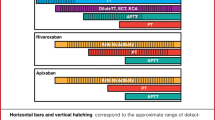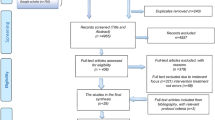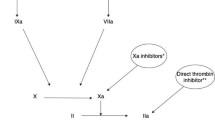Abstract
Stroke and venous thromboembolism continues to be a major cause of morbidity and mortality worldwide. The use of anticoagulation therapy has proven effective in the prevention of stroke and management of thromboembolism; however, initiating treatment may bear clinical burden given the capacity of these agents to cause bleeding. Originally, warfarin has been primarily used, but with the approval of direct oral anticoagulants, therapeutic recommendations have shifted to direct oral anticoagulants for first line therapy for venous thromboembolism for patients without cancer. As compared to warfarin, direct oral anticoagulants are associated with predictable pharmacokinetic profiles, lower bleeding risks, and minimal drug interactions. Complexities in the medication use process can however heighten the risks of causing adverse events. The purpose of this article is to describe common medication errors associated with direct oral anticoagulants, provide practical guidance on the management of direct oral anticoagulants, and suggest strategies to reduce errors. Efforts to minimize medication errors involve the participation of an interdisciplinary team that has standardized policies, risk reduction strategies, and guiding principles to achieve optimal therapeutic outcomes. Current primary literature is not robust in assessment of clinical impact of medication errors associated with DOACs but reports of adverse drug events have been noted. Future studies should be guided to assess clinical outcomes associated with medication errors and identify potential clinical interventions to optimize therapy.


Similar content being viewed by others
References
Barnes GD, Lucas E, Alexander GC, Goldberger ZD (2015) National trends in ambulatory oral anticoagulant use. Am J Med 128(12):1300–135.e2. https://doi.org/10.1016/j.amjmed.2015.05.044
Bristol-Myers Squibb Company (2016) Eliquis®: highlights of prescribing information. https://packageinserts.bms.com/pi/pi_eliquis.pdf. Accessed 3 Oct 2017
Boehringer Ingelheim Pharmaceuticals, Inc (2015) [revised 2018]. Pradaxa®: highlights in prescribing information. https://docs.boehringer-ingelheim.com/Prescribing%20Information/PIs/Pradaxa/Pradaxa.pdf. Accessed 3 Oct 2017
Daiichi Sankyo, Co. (2015) Savaysa®: highlights of prescribing information. http://dsi.com/prescribing-information-portlet/getPIContent?productName=Savaysa&inline=true. Accessed 3 Oct 2017
Janssen Ortho, LLC (2017) Xarelto®: highlights in prescribing information. http://dsi.com/prescribing-information-portlet/getPIContent?productName=Savaysa&inline=true. Accessed 3 Oct 2017
Bristol-Myers Squibb Company (2017) Warfarin®: highlights of prescribing information. https://packageinserts.bms.com/pi/pi_coumadin.pdf. Accessed 3 Oct 2017
Tomaselli GF, Mahaffey KW, Cuker A, Dobesh PP, Doherty JU, Eikelboom JW, Florido R, Hucker W, Mehran R, Messé SR, Pollack CV Jr, Rodriguez F, Sarode R, Siegal D, Wiggins BS (2017) 2017 ACC expert consensus decision pathway on management of bleeding in patients on oral anticoagulation. J Am Coll Cardiol 70(24):3042–3067
Huisman VTEI, Buller HR, Decousus H et al (2017) The changing landscape of stroke prevention in AF: findings from the GLORIA-AF registry phase 2. J AM Coll Cardiol 69(7):777–785
Kearon C, Akl EA, Ornelas J et al (2016) Antithrombotic therapy for VTE disease: CHEST guideline and expert panel report. Chest 149(2):315–352
Kirchhof P, Benussi S, Kotecha D et al (2016) 2016 ESC guidelines for the management of atrial fibrillation developed in collaboration with EACTS. Eur Heart J 37(38):2893–2962
January CT, Wann LS, Alpert JS et al (2014) 2014 AHA/ACC/HRS guideline for the management of patients with atrial fibrillation: a report of the American College of Cardiology/American Heart Association Task Force on practice guidelines and the Heart Rhythm Society. Circulation 130(23):e199–e267
Shoeb M, Fang MC (2013) Assessing bleeding risk in patients taking anticoagulants. J Thromb Thrombolysis 35(3):312–319
Moore T, Cohen M, Furberg C. Quarter W (2016) Quarter 4. 2017. https://www.ismp.org/sites/default/files/attachments/2018-01/2016Q4_1.pdf
Hellenbart EL, Faulkenberg KD, Finks SW (2017) Evaluation of bleeding in patients receiving direct oral anticoagulants. Vasc Health Risk Manag 13:325–342
Granger CB, Alexander JH, McMurray JJ et al (2011) Apixaban versus warfarin in patients with atrial fibrillation. N Engl J Med 365:981–992
Patel MR, Mahaffey KW, Garg J et al (2011) Rivaroxaban versus warfarin in nonvalvular atrial fibrillation. N Engl J Med 365:883–891
Giugliano RP, Ruff CT, Braunwald E et al (2013) Edoxaban versus warfarin in patients with atrial fibrillation. N Engl J Med 369:2093–2104
Ruff CT, Guigliano RP, Braunwald E et al (2014) Comparisons of the efficacy of safety of new oral anticoagulants with warfarin in patients with atrial fibrillation: a meta-analysis of randomized trials. Lancet 383(9921):955–962
Steinberg B, Shrader P, Thomas L et al (2016) Off-label dosing of non-vitamin K antagonist oral anticoagulants and adverse outcomes: the ORBIT-AF II Registry. J Am Coll Cardiol 68(24):2597–2604
Howard M, Lipshutz A, Roess B et al (2017) Identification of risk factors for inappropriate and suboptimal initiation of direct oral anticoagulants. J Thromb Thrombolysis 43:149–156
Viprey M, Jeannin R, Piriou V, Chevalier P, Michel C, Aulagner G, Berthiller J, Armoiry X (2017) Prevalence of drug-related problems associated with direct oral anticoagulants in hospitalized patients: a multicenter, cross-sectional study. J Clin Pharm Ther 42:58–63
Tran E, Duckett A, Fisher S et al (2017) Appropriateness of direct oral anticoagulant dosing for venous thromboembolism treatment. J Thromb Thrombolysis 43:505–513
Whitworth MM, Haase KK, Fike DS, Bharadwaj RM, Young RB, MacLaughlin EJ (2017) Utilization and prescribing patterns of direct oral anticoagulants. Int J Gen Med 10:87–94
Larock AS, Mullier F, Sennesael AL et al (2014) Appropriateness of prescribing dabigatran etexilate and rivaroxaban in patients with nonvalvular atrial fibrillation: a prospective study. Ann Pharmacother 48:1258–1268
Basaran O, Filiz Basaran N, Cekic EG et al (2015) Prescription Patterns of oral anticoagulants in nonvalvular atrial fibrillation (PROPER study). Clin Appl Throm Hemost 23(4):384–391
Hanlon JT, Schmader KE, Samsa GP, Weinberger M, Uttech KM, Lewis IK et al (1992) A method for assessing drug therapy appropriateness. J Clin Epidemiol 45:1045–1045
Conway S, Hwang A, Ponte C, Gums J (2017) Laboratory and clinical monitoring of direct oral anticoagulants: what clinicians need to know. Pharmacotherapy 37(2):236–248
Garkina SV, Vavilova TV, Lebedev DS, Mikhaylov EN (2016) Compliance and adherence to oral anticoagulation therapy in elderly patients with atrial fibrillation in the era of direct oral anticoagulants. J Geriatr Cardiol 13(9):807–810
Favaloro EJ, Lipppi G, Koutts J (2011) Laboratory testing of anticoagulants: the present and the future. Pathology 43:682–692
Blann AD, Lip GYH (2014) Laboratory monitoring of the non-vitamin K oral anticoagulants. J Am Coll Cardiol 64:1140–1142
Ten Cate H (2013) New oral anticoagulants: discussion on monitoring and adherence should start now! Thromb J 11:8
Rodriguez RA, Carrier M, Wells PS (2013) Non-adherence to new oral anticoagulants: a reason for concern during long-term anticoagulation? J Thromb Haemost 11:390–394
Davidson BL, Verheijen S, Lensing AW, Gebel M, Brighton TA, Lyons RM, Rehm J, Prins MH (2014) Bleeding risk of patients with acute venous thromboembolism taking nonsteroidal anti-inflammatory drugs or aspirin. JAMA Intern Med 174(6):947–953
Fitzgerald JL, Howes LG (2016) Drug interactions of direct acting oral anticoagulants. Drug Saf 39:841–845
Henrisksen JN, Nielsen LP, Hellebeck A, Poulsen BK (2017) Medication errors involving anticoagulants: data from the Danish patient safety database. Pharmacol Res Perspect 5(3):e00307
The five rights: destination without A, Map A. Institute For Safe Medication Practices. http://www.ismp.org/resources/five-rights-destination-without-map. (2007). Accessed 8 Aug 2018
Piran S, Schulman S, Panju M et al (2018) Oral anticoagulant dosing, administration, and storage: a cross-sectional survey of Canadian health care providers. J Thromb Thrombolysis 45:180–185
Institute for Safe Medication Practices. Medication Safety Alert. Volume 18, Issue 25. 12 December 2013
Doherty JU, Gluckman TJ, Hucker WJ et al (2017) 2017 ACC Expert Consensus Decision Pathway for Periprocedural Management of Anticoagulation in patients with Nonvalvular Atrial Fibrillation. J Am Coll Cardiol 69(7):871–898
Horlocker T, Vandermeuelen E, Kopp S et al (2018) Regional anesthesia in the patient receiving antithrombotic or thrombolytic therapy. Reg Anesth Pain Med 43(5):566
Portola Pharmaceuticals, Inc, (2018) Andexxa® (coagulation factor Xa (recombinant), inactivated-zhzo) highlights in prescribing information. https://www.andexxa.com/wp-content/uploads/Andexxa%20USPI-v1.4-may2018.pdf. Accessed 12 May 2018
Connolly SJ, Milling TJ, Eikelboom JW et al (2016) Andexanet alfa for acute major bleeding associated with factor Xa inhibitors. N Engl J Med 375(12):1131–1141
Boehringer Ingelheim Pharmaceuticals, Inc, (2015) Praxbind®: highlights in prescribing information. https://docs.boehringer-ingelheim.com/Prescribing%20Information/PIs/Praxbind/Praxbind.pdf. Accessed 3 Oct 2017
Institute for Safe Medication Practices (2017) Medication Safety Self-Assessment® for Antithrombotic Therapy. https://www.ismp.org/assessments/antithrombotic-therapy. Accessed 1 Oct 2017
Burnett AE, Mahan CE, Vazquez SR, Oertel LB, Garcia DA, Ansell J (2016) Guidance for the practical management of the direct oral anticoagulants (DOACs) in VTE treatment. J Thromb Thrombolysis 41:206–232
Kuperman GJ, Bobb A, Payne TH et al (2007) Medication-related clinical decision support in computerized provider order entry systems: a review. J Am Med Inform Assoc 14(1):29–40
Eikelboom JW, Connolly SJ, Brueckmann M, Granger CB, Kappetein AP, Mack MJ, Blatchford J, Devenny K, Friedman J, Guiver K, Harper R, Khder Y, Lobmeyer MT, Maas H, Voigt JU, Simoons ML, Van de Werf F, RE-ALIGN Investigators (2013) Dabigatran versus warfarin in patients with mechanical heart valves. N Engl J Med 369(13):1206–1214
Funding
This study was performed without financial support.
Author information
Authors and Affiliations
Corresponding author
Ethics declarations
Conflict of interest
The authors declare that they have no conflict of interest.
Research involving human participants
This article does not contain any studies with human participants performed by any of the authors.
Rights and permissions
About this article
Cite this article
Barr, D., Epps, Q.J. Direct oral anticoagulants: a review of common medication errors. J Thromb Thrombolysis 47, 146–154 (2019). https://doi.org/10.1007/s11239-018-1752-9
Published:
Issue Date:
DOI: https://doi.org/10.1007/s11239-018-1752-9




